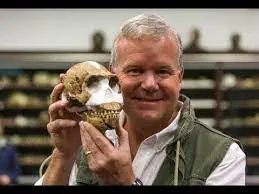Lee Berger on YouTube Zoom Call with John Hawks and Agustin Fuentes, twice affirms his view, that Homo naledi is the ghost species admixture in Africans
 Note – Lee Berger interview can be found on Seth Chagi’s World of Paleoanthropology YouTube channel, Oct. 20. The 1 1/2 long show, Zoom-format, was hosted by Georgina, an anthropology student from the UK.
Note – Lee Berger interview can be found on Seth Chagi’s World of Paleoanthropology YouTube channel, Oct. 20. The 1 1/2 long show, Zoom-format, was hosted by Georgina, an anthropology student from the UK.
In January of 2020, two geneticists at UCLA released a groundbreaking paper announcing the discovery of up to 19% archaic Hominin DNA admixture in modern Africans. As chronicled here at Subspecies, modern Europeans have up to 6% Neanderthal DNA admixture. East Asians have Neanderthal and (Altai) Denisovan admixture. Melanesians and Oceanians have up to 7.8% Neanderthal and (south) Denisovan DNA.
Sriram Sankararaman and Arun Durvasula (photo) described the DNA admixture as a ghost species.
From The Guardian,
Scientists find evidence of ‘ghost population’ of ancient humans
 Scientists have found evidence for a mysterious “ghost population” of ancient humans that lived in Africa about half a million years ago and whose genes live on in people today.
Scientists have found evidence for a mysterious “ghost population” of ancient humans that lived in Africa about half a million years ago and whose genes live on in people today.
the world was once home to many related species or subspecies of human. And when they stumbled upon one another, mating was not out of the question. As a result, modern Europeans carry a smattering of Neanderthal genes, while indigenous Australians, Polynesians and Melanesians carry genes from Denisovans, another group of archaic humans…
Continuing:
according to the scientists’ best estimates, the ghost population split from the ancestors of Neanderthals and modern humans between 360,000 and 1m years ago. The group of perhaps 20,000 individuals then bred with the ancestors of modern west Africans at some point in the past 124,000 years.
“They seem to have made a pretty substantial impact on the genomes of the present day individuals we studied,” Sankararaman said. “They account for 2% to 19% of their genetic ancestry.”
“We do not know what this African population may have been. It is tempting to speculate. But I’ve got to say it is just too soon to know. We haven’t discovered enough fossils in most of Africa to say we know what was there.” Prof. John Hawks, 2020
On June 30, Professor Steven Churchill, a Professor and past Chair of the Department of Evolutionary Anthropology at Duke University, and a member of Dr. Lee Berger’s Homo naledi explorer team at the University of Witwatersrand in South Africa, was a guest on The Dissenter, a popular YouTube show hosted by science enthusiast Ricardo Lopez.
During the interview, Churchill made some startling remarks, which seemed to surprise even the host.
Previously, a number of paleo-anthropologists including Berger and paleo-anthropologist Professor John Hawks of the Univ. of Wisconsin, have hinted around the identity of the mysterious ghost species admixture for modern Africans. But on The Dissenter podcast Dr. Churchill was the first to break protocol and say out loud, that it’s likely Homo naledi.
Excerpts from the show:
 Ricardo: And by now it’s accepted as a new anthropological species.
Ricardo: And by now it’s accepted as a new anthropological species.
Dr. Churchill: I think most of the field accepts that it is a news species and that we were right to name it a new species. There are still some however, who contend that we have just found a more primitive form of Homo erectus. And that this should be called Homo erectus.
Ricardo: What is the time frame we’re talking about when it comes to Homo naledi?
Dr. Churchill: Well, this is the interesting thing. If you look at its anatomy it is very primitive. It has a small brain. 550 cubic centimeters. The average for Homo erectus is about 900 cubic centimeters. So, it has a brain about the size of a Gorilla’s brain. It’s relatively small-bodied. There are aspects of its body that are very primitive… these are features that we see in the Australopiths. A little ape man if you will…
Homo naledi is dated “somewhere between 330 and 250,000 years ago… Our own species Homo sapiens had emerged by that time.” — Dr. Churchill
Continuing:
 Dr. Churchill: When we were finally able to date some of the sentiments in the cave, we were shocked. Because it came out to be somewhere between 330 and 250,000 years ago… Our own species Homo sapiens had emerged by that time.
Dr. Churchill: When we were finally able to date some of the sentiments in the cave, we were shocked. Because it came out to be somewhere between 330 and 250,000 years ago… Our own species Homo sapiens had emerged by that time.
Ricardo: Oh, really?
Dr. Churchill: Yes! So, roughly a quarter of a million years ago, our own species, Homo sapiens, had emerged. By that time…
Ricardo: Yeah, oh yeah, that’s why I was surprised to learn, to know that. Because our species appeared around 100 to 300,000 years ago.
Dr. Churchill: Yes. So here are the interesting, some of the interesting things about Homo naledi, and this is the beautiful thing about paleo-anthropology. We’re discovering new things all the time. And those things are causing us to sort of rethink some of the long held ideas in the field…
Dr. Churchill then made a startling statement: That Homo naledi may be the Hominin species that is admixed with ancestors of modern Africans.
Dr. Churchill: I think that the most plausible explanation for Homo naledi is that it is a species that split off from other lineages from the genus Homo very early in time. Possibly before the emergence of Homo erectus… and for some reason it remains, well, morphologically primitive. Throughout time. It lives to about 250,000 years or so.
So, in that respect people will refer to it as a relic species. A species that diverged early and didn’t change very much over time. But, during that existence it interbred with other members of the genus Homo, including perhaps our species, or ancestors of our species.
And what’s interesting is a work that’s been done on the genome of people who are indigenous to Africa, well, umm, I guess we’re all indigenous to Africa, but to Sub-saharan Africans, identify what they call a ghost lineage which contributed genetically to our lineage. That could be Naledi, or it could be that there are a lot of other things out there that are like Naledi, we just have never discovered them.
Lee Berger, who led the team that discovered Homo naledi in 2013, affirmed his colleague Dr. Churchill’s statement on Homo naledi admixture on a Zoom call show hosted by World of Paleoanthropology on October 20. Berger was even more specific.
During the Q&A portion of the show, John from the UK asked Berger if he’d prefer “what would be more exciting,” that Homo naledi would turn out to be at the base of genus Homo or some late surviving Australopithecine.
“if it’s Species X for example, you know the missing species in the DNA of some African humans… I think there’s a real chance of it by the way…” — Dr. Berger
Berger (1:21 minutes):
 Each of us will have a different answer on this. But I certainly hope I didn’t imply that it would be on the line leading to humans. Whether you’re going to find some small levels of introgression with Homo naledi in populations of you know, shows up in our DNA of some people in the world today at levels, that wouldn’t surprise me at all. Whether that has any real bearing on later things I don’t know.
Each of us will have a different answer on this. But I certainly hope I didn’t imply that it would be on the line leading to humans. Whether you’re going to find some small levels of introgression with Homo naledi in populations of you know, shows up in our DNA of some people in the world today at levels, that wouldn’t surprise me at all. Whether that has any real bearing on later things I don’t know.
But I know my easy answer. I would absolutely love it if Naledi had nothing to do with you know the molecular origins of that other than sharing a last common ancestor deep in time…
John and Agustin and other people could attest, I’ve often said, man I would love for Naledi to not be related to humans. I think that, you know, whether it is an internal or endless debate, whether it does have small amounts of introgression, if it’s Species X for example, you know, the missing species in the DNA of some African humans, it’s there. That may not, John’s the geneticist he can talk more on the meaning or impact of that. That’s my honest answer to your question.
I think there’s a real chance of it by the way, for it to be true. John?
“I wonder… whether we may be part Naledi…” — John Hawks
John Hawks then went on to suggest that Homo naledi is the center of the story of human origins, because of the simple geography of being discovered in south Africa. He then added:
Anything we find in Africa in this time period. Our story has to accommodate the diversity that is already there. And that doesn’t mean that diversity is a pearl inside of human genetics. I wouldn’t think that at all. I wonder whether there are connections, or whether, not withstanding whether we may be part Naledi, whether Naledi is in some large part us…



Many South Africans have morphological traits, particularly facial morphology, that are similar to Homo naledi. — Subspecieist Asst. Editor, Martha Christina, South Africa
Latenight bad idea, forget my post please.